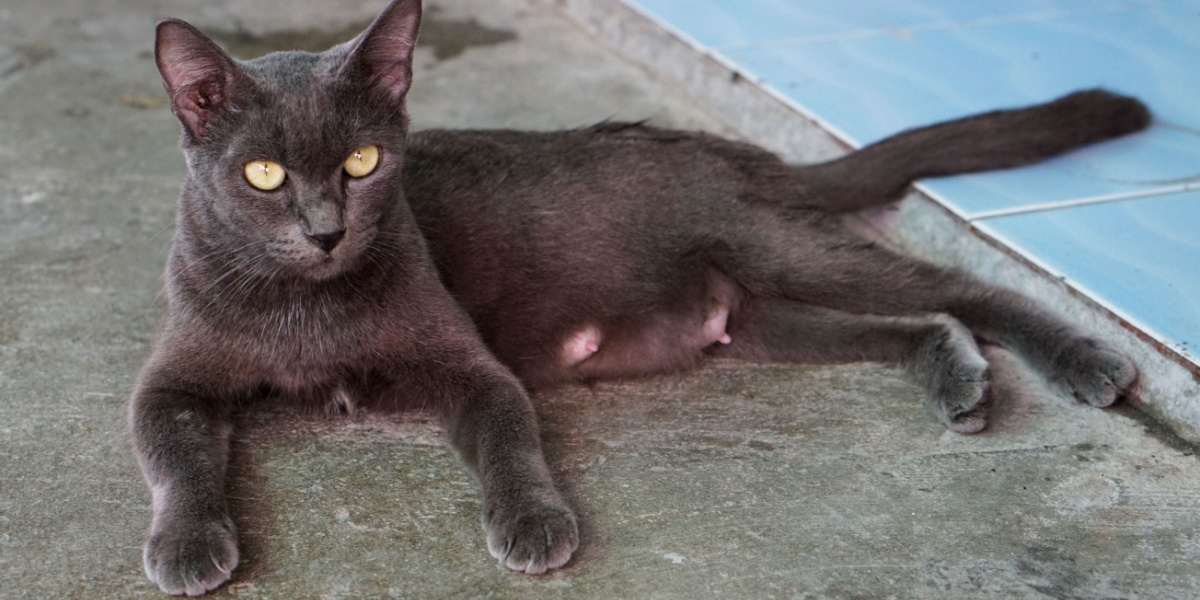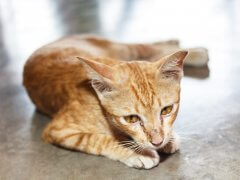Quick Overview: Disease Summary
Mastitis in cats occurs when a mammary gland (breast tissue) becomes enlarged and inflamed. Cats have eight mammary glands, and mastitis can affect just one gland or multiple glands at once.
It can be a painful condition that results in severe inflammation, infection and damage to the glands. Not every cat is at risk of mastitis and there are some preventatives that will help this from occurring. In this article, I’ll discuss common causes of mastitis, symptoms and treatments.
Causes of Mastitis in Cats
Mastitis is the inflammation of the mammary gland(s). This most commonly occurs in female cats that are not spayed, as their mammary glands undergo changes during pregnancy and lactation which can lead to mastitis. However, any cat can be at risk of mastitis.
Common causes of mastitis in cats include:
Feeding Kittens
Cats that are feeding kittens are more prone to mastitis than other cats. Mastitis can occur if a gland isn’t emptied fully during feeding and accumulates with milk. This can cause inflammation of the gland leading to pain and potentially a bacterial infection. The weaning period or a sudden cessation of nursing (e.g. with the death of a kitten), may cause this to happen.
Infection from Environment
Mammary glands are in close proximity to the ground when a cat is standing or lying down. The glands can become infected when bacteria from the environment travels up the teat into the gland. This is more common in unhygienic, damp environments and cats that are feeding kittens.
Damaged Teat
If a teat becomes damaged or traumatised (e.g. through kittens suckling or an unrelated injury) this may allow bacteria to enter the gland and cause infection. Damaged teats may also have issues emptying and may accumulate with milk, leading to mastitis.
Damage to the Gland
If the mammary gland itself becomes damaged (such as through a fall or blunt trauma) and inflamed, it can cause mastitis, without the presence of an infection or kittens.
Mammary hyperplasia
Enlargement of the mammary glands due to hormonal influence or mammary neoplasia (cancer) can sometimes look like mastitis. They will both cause enlarged glands and there may be pain, colour change of the skin or discharge from the gland.
Symptoms of Mastitis in Cats
Now that you know what causes mastitis, it’s important that you know how to recognise the signs of it. Mastitis is painful, and can cause severe damage to the mammary glands. The earlier your cat gets treatment, the best chance she has of recovery.
Common signs of mastitis include:
- Enlarged mammary gland
- Reddened gland
- Heat around gland
- Discharge from teat – may have blood or pus
- Milk with blood or pus
- Colour change to skin (purple or red)
- Pain when gland is touched
- Open wound or abscess on the gland
Along with these specific mammary glands signs, there may also be other signs in the later stages that your cat is unwell:
- Reduced appetite
- Reduced drinking
- Fever
- Lethargy
Complications of Having Mastitis
Mastitis is painful and can affect milk production, so care must be taken if there are young kittens relying on the mother cat for milk.
As well as causing discomfort to the cat, mastitis can cause complications if she is feeding kittens. Cats affected by mastitis may not want kittens near their affected glands or even if they allow the kittens to feed, the kittens may not be able to get any milk if the gland isn’t able to empty. This can lead to kittens becoming underweight or failing to thrive. If you have a mother cat and kittens and you notice any issues with kittens, be sure to check the mother’s mammary glands.
Diagnosis of Mastitis in Cats
If you think that your cat has any signs of mastitis described above, you should contact your veterinarian immediately. Mastitis is a very painful condition but luckily your vet will be able to prescribe medication.
Your vet will likely diagnose mastitis based on the history you provide and the physical exam of your cat. If the mastitis is severe or complicated, your vet may take a milk sample from the gland. They can use this to check if bacteria is present in the gland and if so, they can test to see what bacteria is growing and what antibiotic is best to treat the infection.
In cats that are very unwell, your vet may also run some routine blood and urine testing to check their underlying organ function.
Treatment for Mastitis in Cats
After diagnosis, the treatment for mastitis will most commonly revolve around antibiotics and adequate pain relief. This may involve anti-inflammatories and pain-killers. Your vet may prescribe antibiotics based on a culture of the milk.
In cases where cats are severely unwell, it’s possible that the infection from the gland has spread to their body. These cases may require hospitalisation for intravenous fluids and intravenous broad-spectrum antibiotics. Some glands with mastitis may form an abscess or have necrotic dying tissue, in these cases your vet may need to perform surgery to remove the gland.
Your vet may recommend that the gland needs to be hand milked every 6 hours or so. This will empty the gland which will help with pain and it will also help bacteria to drain out. Engorged glands are a common cause of mastitis and if not the main cause in certain cases, it’ll certainly make the problem worse.
Cat Care Tips
Cats with mastitis often feel unwell, and may need some help with basic care such as eating and drinking.
Most cases of mastitis are treated at home. In this case you will need to care for your cat and monitor her progress. We have some tips to help care for your cat with mastitis;
- Stick to the medication schedule: ensuring that your cat receives all of her antibiotics and pain-killers at the right times will help to speed up her recovery. Missed doses or half-eaten doses will hinder her progress. If you’re struggling to give medication to your cat, ask your vet for other options and advice.
- Cool or warm compresses: your vet may recommend cool or warm compresses to help the gland to heal. Cabbage leaves are also commonly used and are held or secured against the gland.
- Lots of TLC: your cat will need lots of care and nursing when they are unwell. They might need help to eat and drink if it’s sore for them to move, in this case you may need to bring the bowls to them. Be mindful that your cat is unwell and painful and may need help to do minor things at home.
Always ring your vet if you’re concerned that your cat isn’t improving or doing as well as you’d expect.
Prevention of Mastitis in Cats
As mastitis is most common in cats that are pregnant or feeding kittens, spaying cats is a major preventative of mastitis. Discuss this with your veterinarian, as they may want to postpone the spay surgery until your cat is fully recovered from mastitis.
If your cat has had kittens, keep a close eye on them to ensure they are feeding regularly, and feeding from all the mothers’ glands. This can help prevent engorgement, which is a risk factor for mastitis.
Also Read: Early-Age Spaying & Neutering Of Cats
Frequently Asked Questions
How do you treat mastitis in cats?
Mastitis in cats is often treated with antibiotics and pain relief medication. Severe cases may need surgery.
Can mastitis in cats go away?
Yes mastitis in cats can go away, but it does require the appropriate medical treatment. Most cases need 1-3 weeks of treatment from their vets.
Can you treat mastitis in cats at home?
Most cases of mastitis in cats are treated at home, but will need to be diagnosed and prescribed medication by a vet. Your vet may also advise you on home care such as to hand-milk to empty the gland and to apply compresses.
What does mastitis in cats feel like?
Mastitis is a very painful and uncomfortable condition. Affected cats may be painful and feel unwell, often with a reduced appetite and fever.










